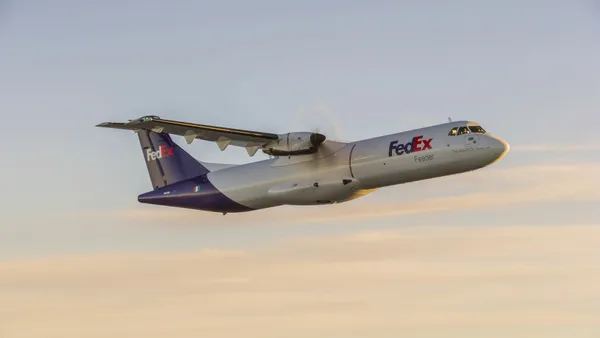Dive Brief:
- Air cargo rates dropped for the third consecutive month in November as demand slows and shippers flock to an improved ocean landscape, according to a Dec. 7 update from Xeneta’s Clive Data Services.
- In November, rates on the China-North America trade lane fell more than 40% YoY, Freightos reported last week. Spot rates on the general TransPacific lane were down 32% YoY, though still higher than pre-pandemic levels, according to Clive Data Services.
- Despite hopes for a late peak season boost, demand fell 2% in November compared to October, with volumes declining for the ninth consecutive month, according to Clive.
Dive Insight:
Some retailers saw financial and operational benefits in Q3 as air cargo rates and volumes continued to soften. Gap, for instance, reported improved operating margins during the quarter as lower air freight rates normalized.
Athletic apparel company Lululemon also saw increased product margins in Q3 driven by moderating air freight costs, and expects gross margins to further improve YoY in Q4, CFO Meghan Frank said during an earnings call this month.
As of this week, air freight rates from Asia to the U.S. remain on a steady decline. The current rate for shipments from China to the U.S. is roughly $6.14 per kilogram as of Dec.12, down 56% YoY, according to the TAC Index. This year, air rates on this trade lane hit a peak of $12.18 per kilogram in early January.
Rates from Vietnam to the U.S. stand at $3.79 per kilogram, down 79% YoY.
Meanwhile, ocean transport’s improved market landscape has prompted some retailers to move shipments away from air freight and back onto boats, despite longer transit times, C.H. Robinson President and CEO Bob Biesterfeld said on an earnings call last month. During Q3, the company’s air cargo business declined 21% YoY, driven by a 17% decrease in metric tons shipped.
Victoria’s Secret is one of the retailers moving away from air freight in favor of ocean transport to help abate supply chain costs, which increased by roughly $300 million last holiday season.
Looking ahead, shippers are expected to see ongoing benefit from softening rates in both air and ocean, potentially lowering shipping costs in 2023, Xeneta’s Chief Airfreight Officer Niall van de Wouw said in a monthly update. In turn, industry stakeholders are opting for shorter capacity commitments.
“Amid so much market uncertainty, industry parties are increasingly choosing shorter-term deals as they wait to see how business trends unfold in the coming months,” van de Wouw said. “Distribution of contract rates for shippers shows commitments of over three-month contracts hardly exist in Q4 this year.”














